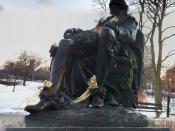In the poems "Sonnet 116" by William Shakespeare and "Cold in the Earth" by Emily Brontø the theme of love is clearly expressed in numerous ways and reflects one of the strongest human bonds.
In "Sonnet 116", Shakespeare describes love in its most ideal form, as an eternal, everlasting bond between two people that can withstand physical changes caused by the passing of time. Love is described as unchanging and unalterable. The first two lines are an allusion to the words of the Marriage Service: 'If any of you know cause or just impediment why these two persons should not be joined together in holy matrimony'. 'If either of you know any inward impediment why you should not be conjoined'. Showing the immediate link of love and marriage as well as establishing that when one truly loves, there can be no 'impediments' through change of circumstances, physical appearance, or temporary lapses in conduct.
One way in which Shakespeare strongly shows the power of love is through metaphors, for example in the second quatrain Shakespeare compares love to 'the star to every wandering bark.' This metaphor says that when two people get lost in their relationship or lives, they can always look to love to lead the way and be their guiding star. Shakespeare backs up this point when he says that it 'looks on tempests and is never shaken' meaning that love will withstand the fiercest troubles, similar to standing its ground in a storm.
In the third quatrain, Shakespeare makes references to how a person may change but that love will never fade. He states 'Love's not Time's fool, although rosy lips and cheeks within his bending sickle's compass come'. By personifying time he gives the image of a man swiping with...



Sweet
well argued, clear points good ref's, the intro or thesis could use some work though kind of awkward wording
3 out of 3 people found this comment useful.